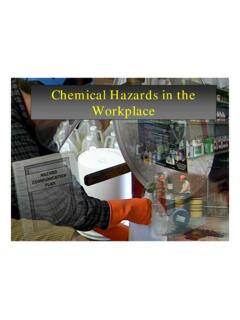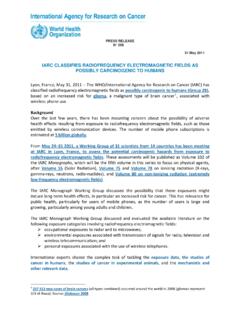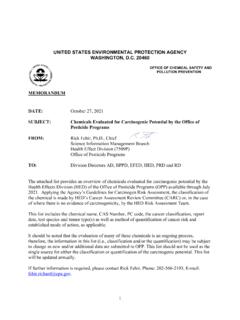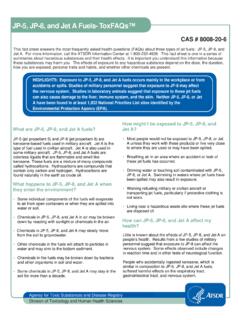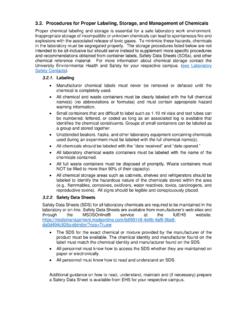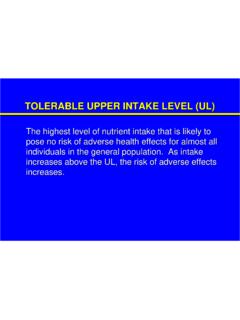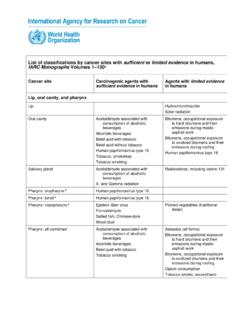Transcription of Comparison of NFPA 704 and HazCom 2012 Labels
1 NFPA 704 HazCom 2012 PurposeProvides basic information for emergency personnel responding to a fire or spill and those planning for emergency workers about the hazards of chemicals in workplace under normal conditions of use and foreseeable System:NFPA Rating and OSHA s Classification System0-40-least hazardous4-most hazardous1-41-most severe hazard4-least severe hazard The Hazard category numbers are NOT required to be on Labels but are required on SDSs in Section 2. Numbers are used to CLASSIFY hazards to determine what label information is Provided on Label Health-Blue Flammability-Red Instability-Yellow Special Hazards*-White* OX Oxidizers W Water Reactives SA Simple Asphyxiants Product Identifier Signal Word Hazard Statement(s) Pictogram(s) Precautionary statement(s); and Name address and phone number of responsible Hazards on LabelAcute (short term) health hazards hazards are more typical for emergency response health effects are not covered by NFPA (short term) and chronic (long term) health hazards.
2 Both acute and chronic health effects are relevant for employees working with chemicals day after day. Health hazards include acute hazards such as eye irritants, simple asphyxiants and skin corrosives as well as chronic hazards such as Hazards on LabelNFPA divides flammability and instability hazards into two separate numbers on the label. Flammability in red section Instability in yellow sectionA broad range of physical hazard classes are listed on the label including explosives, flammables, oxidizers, reactives, pyrophorics,combustible dusts and to get information to place on labelRating system found in NFPA Fire Protection Guide to Hazardous Materials ORNFPA 704 Standard System for Identification of the Hazards of Materials for Emergency Response 2012 Edition.
3 Tables , , and Chapter 8 of NFPA 704 OSHA Hazard Communication Standard 29 CFR (2012).1) Classify using Appendix A (Health Hazards) and Appendix B (Physical Hazards)2) Label using Appendix COtherThe hazard category numbers found in section 2 of the HC2012 compliant SDSs are NOT to be used to fill in the NFPA 704 information may also appear on the label such as any hazards not otherwise classified, and directions for of NFPA 704 and HazCom 2012 LabelsOSHA 3678-08 2013 QUICK CARDTMN ational Fire Protection (800) 344-3555 For more information:The substance: NOMIXUP 7042012 To create an OSHA label per HazCom 2012:Step 1.
4 Perform the classification in accordance with Appendix A: Health Hazards & Appendix B Physical Hazards of 29 CFR this is where you find the criteria for each hazard class and hazard : Flammable Gas, Category 1 Class: carcinogen , Category 1 BClass: Specific Target Organ Toxicity (Single Exposure), Category 3 Class: Substances and Mixtures Which, in Contact with Water, Emit Flammable Gases, Category 3 Step 2: Gather labeling information (Pictograms, Signal Word, Hazard Statements) from Appendix C of 29 CFR based on the chemical s hazard class and 3: Create the LabelTo Create NFPA 704 label:Step 1: Collect information on hazards from applicable sections of SDS.
5 Some SDSs may provide the NFPA diamond symbol with hazard rating numbers filled in already. Note: Do NOT use the hazard category numbers given in section 2 of HazCom 2012 compliant SDS on 704 label!If the diamond is not provided on the SDS you can obtain the information under the following sections of the SDS. Note that additional information may be provided in other sections of the SDS. Health hazard information under Section 11 Flammability information under Section 9 Instability information under Section 10 Special information under Section 9, 10, 11 Step 2: Obtain current edition copy of NFPA 704 or view on line at Compare the criteria on the SDS sections as shown above with the criteria shown in Tables (Health), (Flammability), (Instability) and (Special Hazards).
6 Step 3: Place numbers for the degree of hazard associated with the criteria obtained in Step 2 in the correct quadrant of NFPA 704 3678-08 2013 QUICK CARDTMN ational Fire Protection (800) 344-3555 For more information.










